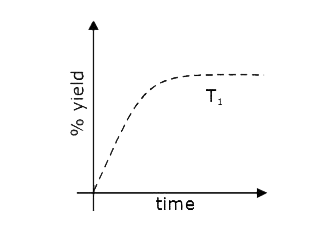Dinitrogen and dihydrogen react with each other to produce ammonia according to the following chemical equation:
N2(g)+H2(g)→2NH3(g)
a. Calculate the mass of ammonia produced if 2.00×103g dinitrogen reacts with 1.00×103g of dihydrogen.
b. Will any of the two reactants remain unreacted?
c. If yes, which one and what would be its mass?
1mol of N2, i.e., 28g reacts with 3 mole of H2, i.e., 6g of H2.
∴2000g of N2 will react with H2=628×200g=428.6g. Thus, N2 is the limiting reagent while H2 is the excess reagent.
2mol of N2, i.e., 28g of N2 produces NH3=2mol
=34g
Therefore, 2000g will produces NH3=3428×2000g
=2428.57g.
b. H2 will remain unreacted.
c. Mass left unreacted =1000g−428.6g=571.4g
Topper's Solved these Questions
- BOOK - CENGAGE CHEMISTRYCHAPTER - NCERT BASED EXERCISEEXERCISE - Redox Reaction25videos
NCERT BASED EXERCISE
- BOOK - CENGAGE CHEMISTRYCHAPTER - NCERT BASED EXERCISEEXERCISE - Atomic Structure94videos
NCERT BASED EXERCISE
- BOOK - CENGAGE CHEMISTRYCHAPTER - ISOMERISMEXERCISE - Assertion-Reasoning Type1videos
ISOMERISM
- BOOK - CENGAGE CHEMISTRYCHAPTER - ORGANIC REACTION MECHANISMEXERCISE - Analytical and Descriptive6videos
ORGANIC REACTION MECHANISM
Similar Questions
Dinitrogen and dihydrogen react with each other to produce ammonia according to the following chemical equation:
N2(g)+3H2(g)→2NH3(g)
a. Calculate the mass of ammonia produced if 2.00×103g dinitrogen reacts with 1.00×103g of dihydrogen.
b. Will any of the two reactants remain unreacted?
c. If yes, which one and what would be its mass?View SolutionThe heat change for the reaction,
N2(g)+3H2(g)→2NH3(g)
is -92.2kJ. Calculate the heat of formation of ammonia.View Solution
Knowledge Check
- Question 1 - Select One
Which of the following is correct for the reaction? N2(g)+3H2(g)→2NH3(g)
AKP=KcBKP<KcCKP>KcDPressure is required to predict the correlation - Question 2 - Select One
Which of the following is correct for the reaction?
N2(g)+3H2(g)⇔2NH3(g)AKp=KcBKp<KcCKp>KcDPressure is required to predict the correlation - Question 3 - Select One
Which of the following is correct for the reaction?
N2(g)+3H2(g)⇔2NH3(g)AKp=KcBKp<KcCKp>KcDPressure is required to predict the correlation
For the chemical reaction
N2(g)+3H2(g)⇔2NH3(g)
The correct option is:View SolutionThe % yield of ammonia as a function of time in the reaction N2(g)+3H2(g)⇔2NH3(g),(g)ΔH<0 at (P,T1) is given below
 View Solution
View SolutionFor the chemical reaction
N2(g)+3H2(g)⇔2NH3(g)
The correct option is:View SolutionFor the chemical reaction
N2(g)+3H2(g)⇔2NH3(g)
The correct option is:View SolutionWhich one of the following equation is correct forr the reaction : N2(g)+3H2(g)→2NH3(g) ?
View Solution

